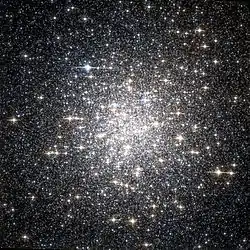| NGC 5986 | |
|---|---|
 NGC 5986 by Hubble Space Telescope; 3.5′ view | |
| Observation data (J2000 epoch) | |
| Class | VII[1] |
| Constellation | Lupus |
| Right ascension | 15h 46m 03.00s[2] |
| Declination | –37° 47′ 11.1″[2] |
| Distance | 33.9 kly (10.4 kpc)[3] |
| Apparent magnitude (V) | 8.0 |
| Apparent dimensions (V) | 5' |
| Physical characteristics | |
| Absolute magnitude | −8.44[4] |
| Mass | 5.99×105[3] M☉ |
| Metallicity | = −1.35[5] dex |
| Estimated age | 12.16 Gyr[5] |
| Other designations | ESO 329-SC 018, NGC 5986[6][7] |
NGC 5986 is a globular cluster of stars in the southern constellation of Lupus, located at a distance of approximately 34 kilolight-years from the Sun.[3] It was discovered by Scottish astronomer James Dunlop on May 10, 1826. John L. E. Dreyer described it as, "a remarkable object, a globular cluster, very bright, large, round, very gradually brighter middle, stars of 13th to 15th magnitude".[8] Its prograde–retrograde orbit through the Milky Way galaxy is considered irregular and highly eccentric. It has a mean heliocentric radial velocity of +100 km/s.[4] The galacto-centric distance is 17 kly (5.2 kpc), which puts it in the galaxy's inner halo.[9]
This is relatively massive cluster has been poorly studied, at least as of 2017.[4] It is moderately concentrated, with a core radius of 28.2″ and a projected half-light radius of 58.8″. The three dimensional half-mass radius is ~78.16″.[10] The cluster has a higher metallicity – what astronomers term the abundance of elements with higher atomic number then helium – compared to most other objects of its type.[11] It may have at least 4–5 different stellar populations with distinct elemental compositions, and there is evidence that it has lost ~60–80% of its original mass.[4]
Further reading
- Alves, David R.; et al. (January 2001). "CCD Photometry of the Globular Cluster NGC 5986 and Its Post-Asymptotic Giant Branch and RR Lyrae Stars". The Astronomical Journal. 121 (1): 318–326. arXiv:astro-ph/0010095. Bibcode:2001AJ....121..318A. doi:10.1086/318030. S2CID 119093584.
References
- ↑ Shapley, Harlow; Sawyer, Helen B. (August 1927), "A Classification of Globular Clusters", Harvard College Observatory Bulletin, 849 (849): 11–14, Bibcode:1927BHarO.849...11S.
- 1 2 Goldsbury, Ryan; et al. (December 2010), "The ACS Survey of Galactic Globular Clusters. X. New Determinations of Centers for 65 Clusters", The Astronomical Journal, 140 (6): 1830–1837, arXiv:1008.2755, Bibcode:2010AJ....140.1830G, doi:10.1088/0004-6256/140/6/1830, S2CID 119183070.
- 1 2 3 Boyles, J.; et al. (November 2011), "Young Radio Pulsars in Galactic Globular Clusters", The Astrophysical Journal, 742 (1): 51, arXiv:1108.4402, Bibcode:2011ApJ...742...51B, doi:10.1088/0004-637X/742/1/51, S2CID 118649860.
- 1 2 3 4 Johnson, Christian I.; et al. (June 2017). "Chemical Complexity in the Eu-enhanced Monometallic Globular NGC 5986". The Astrophysical Journal. 842 (1): 21. arXiv:1705.10840. Bibcode:2017ApJ...842...24J. doi:10.3847/1538-4357/aa7414. S2CID 119279995. 24.
{{cite journal}}: CS1 maint: multiple names: authors list (link) - 1 2 Forbes, Duncan A.; Bridges, Terry (May 2010), "Accreted versus in situ Milky Way globular clusters", Monthly Notices of the Royal Astronomical Society, 404 (3): 1203–1214, arXiv:1001.4289, Bibcode:2010MNRAS.404.1203F, doi:10.1111/j.1365-2966.2010.16373.x, S2CID 51825384.
- ↑ "NASA/IPAC Extragalactic Database". Results for NGC 5986. Retrieved 2007-04-06.
- ↑ "NGC 5986". SIMBAD. Centre de données astronomiques de Strasbourg. Retrieved 2020-02-25.
- ↑ Seligman, Courtney. "New General Catalogue objects: NGC 5950 - 5999". cseligman.com. Retrieved 2020-09-20.
- ↑ Ortolani, S.; et al. (October 2000). "Colour-magnitude diagrams of the inner halo globular clusters NGC 5986 and NGC 6712". Astronomy and Astrophysics. 362: 953–958. Bibcode:2000A&A...362..953O.
- ↑ Lanzoni, B.; et al. (September 2018), "The ESO Multi-instrument Kinematic Survey (MIKiS) of Galactic Globular Clusters: Solid-body Rotation and Anomalous Velocity Dispersion Profile in NGC 5986", The Astrophysical Journal, 865 (1): 9, arXiv:1808.01194, Bibcode:2018ApJ...865...11L, doi:10.3847/1538-4357/aad810, S2CID 119414659, 11.
- ↑ Moni Bidin, C.; et al. (May 2009). "A lack of close binaries among hot horizontal branch stars in globular clusters. M 80 and NGC 5986". Astronomy and Astrophysics. 498 (3): 737–751. arXiv:0903.2072. Bibcode:2009A&A...498..737M. doi:10.1051/0004-6361/200810579. S2CID 16080323.
External links
 Media related to NGC 5986 at Wikimedia Commons
Media related to NGC 5986 at Wikimedia Commons- NGC 5986 on WikiSky: DSS2, SDSS, GALEX, IRAS, Hydrogen α, X-Ray, Astrophoto, Sky Map, Articles and images